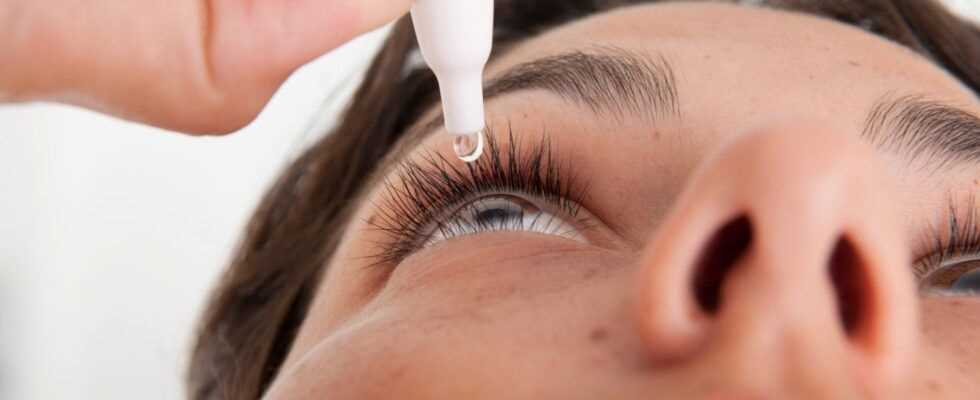Sjogren's syndrome is a chronically progressive disease in which the immune system overreacts and is directed against secretion-forming glands in the body. The salivary and lacrimal glands are particularly affected, but the whole body can also be affected. Everything about autoimmune disease symptoms and treatment.
- Eye drops can help with dry eyes caused by Sjogren's syndrome.
- © iStock.com/4FR
After rheumatoid arthritis, Sjögren's syndrome is the second most common inflammatory rheumatic disease: four out of 1,000 people in Germany are affected, 90 percent of them are women. The disease usually occurs between the ages of 40 and 50 – either as a separate disease (primary) or in connection with other autoimmune diseases (secondary). The disease takes its name from the Swedish ophthalmologist Henrik Sjögren, who scientifically described the syndrome for the first time.
At a glance:
Forms of Sjogren's syndrome
When Sjogren's syndrome occurs without any other underlying conditions, it is called primary Sjogren's syndrome. In secondary Sjogren's syndrome, the disease occurs as a side effect of other autoimmune diseases. The most common are lupus erythematosus, rheumatoid arthritis, limited and progressive systemic sclerosis, multiple sclerosis and myasthenia gravis.
Causes: What is Sjogren's Syndrome?
The causes of Sjogren's syndrome are not known. Doctors suspect that infections, stress, or changes in hormonal balance play a role. As with many autoimmune diseases, a hereditary predisposition for the development of Sjogren's syndrome is assumed – this is indicated by the fact that many affected have relatives who suffer from an inflammatory form of rheumatism.
Anyone who is affected by an inflammatory rheumatic disease has a high risk of developing Sjögren's syndrome as well. Around a third of people with rheumatoid arthritis, lupus erythematosus or another collagenosis (disease of the connective tissue) also develop secondary Sjogren's syndrome.
Symptoms of Sjogren's Syndrome
The attack of the immune system on the salivary and lacrimal glands causes inflammation, inhibits secretion formation and can destroy the glandular tissue. The chronic disturbance of the glandular function leads to the most noticeable symptom of Sjogren's syndrome: persistent dry eyes and mouth (sicca symptoms).
However, other glands and mucous membranes can also be affected by the inflammation-related dehydration, especially in the gastrointestinal tract, in the airways and the vagina. The lack of vaginal mucus often makes sexual intercourse painful and makes it easier for viruses, bacteria and fungi to get into the vagina and uterus.
In many Sjögren sufferers, the disease also spreads to the musculoskeletal system. The result is inflamed joints as well as joint and muscle pain. Temporarily swollen salivary glands and cervical lymph nodes, skin changes and circulatory disorders in the fingers (Raynaud's syndrome) can also occur. In rare cases, the lungs, kidneys, blood vessels or the nervous system are also affected. People with Sjogren's syndrome have an approximately 40-fold increased risk of developing extranodal non-Hodgkin's lymphoma, which is why regular check-ups are very important.
Most of those affected, however, suffer from severe chronic fatigue, which can significantly impair their quality of life and ability to work.
How do you diagnose Sjogren's syndrome?
Since the main symptoms of Sjogren's syndrome (dry mouth and dry eyes) can have numerous other causes, the disease is often not recognized for years. The diagnosis is often only made after menopause. However, it is assumed that Sjögren's syndrome has existed for a long time and usually breaks out between the ages of 20 and 30.
If Sjogren's syndrome is suspected, measurements of tear and saliva production are first made. In the so-called Schirmer test, the amount of tear fluid produced is measured with a filter paper strip under the lower eyelid – in a person with Sjögren's syndrome this is often a third less than in healthy people. The so-called Saxon test works in a similar way: Here, the amount of saliva produced is recorded with the help of a swab of cotton wool to be chewed.
If the production of tears and / or saliva is reduced, the next step is to check whether certain autoantibodies (SS-A (Ro) and SS-B (La)) can often be detected in the blood. These can be found in many, but not all, Sjögren sufferers. The erythrocyte sedimentation rate (ESR) is increased in around 70 percent, the number of red blood cells is reduced in around 33 percent (anemia) and in up to 25 percent the number of certain white blood cells is too low (leukopenia).
If Sjögren's syndrome is still suspected despite the lack of evidence in the blood, a salivary gland biopsy can be arranged. A small piece of tissue is removed and examined for inflammation and other damage.
Therapy for Sjogren's syndrome
There is no cure for Sjogren's syndrome, but there are numerous options available for symptom relief. Artificial tears and saliva, nasal and vaginal gels can help against the symptoms of dryness. Adequate hydration and high humidity keep the mucous membranes moist, and chewing sugar-free gum stimulates saliva production. Intensive dental care should be carried out to prevent tooth decay; regular professional teeth cleaning is recommended. Treatment with the drugs pilocarpine and bromhexine can significantly alleviate the sicca symptoms.
The intermittent joint pain and swelling can often be relieved with anti-inflammatory pain relievers. If these drugs do not work well enough, doctors resort to agents that are also used to treat rheumatoid arthritis – including antimalarials, cortisone and immunosuppressants. Aerobic endurance training and good sleep hygiene are used to treat fatigue.
In principle, the therapy should be carried out by an interdisciplinary team of general practitioners, internal rheumatologists, ophthalmologists, ENT specialists and dentists. Depending on the organ involvement, gynecologists, pulmonologists, neurologists and other specialists may also have to be consulted.
Course and prognosis: how dangerous is Sjogren's syndrome?
People with Sjogren's syndrome have a normal life expectancy; the quality of life depends on which comorbidities are present. Regular dental and ophthalmological examinations are important to avoid permanent damage. If internal organs are involved, permanent damage to the lungs, kidneys, blood vessels or nerves can occur in rare cases. In addition, Sjogren's syndrome promotes the development of malignant lymphoma, which is why regular cancer screening examinations are of great importance.


